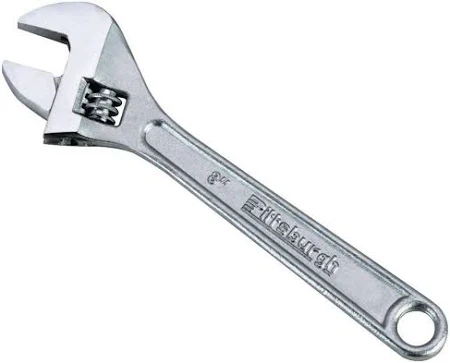An adjustable wrench is a handy tool found in many toolboxes. It can fit different sizes of nuts and bolts. This makes it very useful for many jobs around the house or in the workshop.
An adjustable wrench is used to tighten or loosen nuts and bolts of various sizes. It has a movable jaw that can be adjusted to fit the fastener. This feature allows one tool to do the job of many fixed-size wrenches.
People use adjustable wrenches for many tasks. They can fix plumbing pipes or build furniture. The wrench is also great for car repairs and home improvement projects. Its versatility makes it a must-have tool for both pros and DIY fans.
Understanding Adjustable Wrenches
Adjustable wrenches are useful tools for gripping and turning nuts and bolts. They have a movable jaw that can be adjusted to fit different sizes. This makes them very handy for many tasks.
Basic Features of Adjustable Wrenches
An adjustable wrench has a fixed jaw and a movable jaw. The movable jaw slides up and down to change the size. A screw mechanism controls this movement. The handle is usually longer than the head to give more leverage.
Most adjustable wrenches are made of steel or chrome vanadium. They come in many sizes from 4 inches to 24 inches long. The size refers to the length of the wrench.
To use an adjustable wrench:
- Open the jaws wide enough
- Put the jaws around the nut or bolt
- Turn the screw to tighten the jaws
- Turn the wrench to loosen or tighten
Types and Variations
There are several types of adjustable wrenches:
- Standard adjustable wrench: The most common type
- Pipe wrench: Used for gripping round pipes
- Monkey wrench: An older style with very wide jaws
- Basin wrench: For hard-to-reach places under sinks
Some adjustable wrenches have special features. Locking adjustable wrenches can lock onto a nut or bolt. This gives a tighter grip. Wide-jaw adjustable wrenches can open extra wide for bigger jobs.
The quality of adjustable wrenches can vary. Better ones have smoother movement and stronger jaws. They also tend to last longer.
Practical Applications and Maintenance
Adjustable wrenches are useful for many jobs. They can tighten or loosen nuts and bolts of different sizes. Taking care of your wrench helps it last longer.
Professional and DIY Uses
Adjustable wrenches are great for plumbing, car work, and building things. Plumbers use them to fix pipes. Mechanics use them on car parts. DIY fans use them to put furniture together.
These tools work well in tight spots. They can grip nuts and bolts in hard-to-reach places. This makes them perfect for tricky jobs.
Pros and hobbyists like adjustable wrenches. They’re good for both big and small tasks. You can use them on many sizes of fasteners.
Best Practices for Use and Care
To use an adjustable wrench right, follow these steps:
- Open the jaws wide enough for the nut or bolt
- Turn the worm gear to close the jaws tightly
- Put the wrench on the nut with the moving jaw facing you
- Turn the wrench toward the moving jaw for best grip
Clean your wrench after each use. Wipe off dirt and grease. This keeps it working well.
Store the wrench in a dry place. Oil it now and then to prevent rust. Don’t use it as a hammer or pry bar. This can damage the tool.
Be careful not to over-tighten nuts. This can strip the threads. Always use the right size wrench for the job to avoid injury.
Frequently Asked Questions
Adjustable wrenches are handy tools with many uses. They can tighten or loosen nuts and bolts of different sizes. Let’s look at some common questions about these tools.
How can an adjustable wrench be used in automotive maintenance?
An adjustable wrench is great for car repairs. It can loosen or tighten nuts and bolts on many car parts. You can use it to change oil filters or fix loose parts under the hood. Its adjustable jaw makes it useful for many sizes of fasteners.
What are the typical applications for an adjustable wrench?
Adjustable wrenches have many uses. They work well for plumbing jobs and fixing bikes. You can use them to assemble furniture or tighten loose screws. They’re also good for basic home repairs and DIY projects.
What should be considered when using an adjustable wrench to tighten or loosen bolts?
When using an adjustable wrench it’s important to set the jaw size right. Make sure it fits the bolt snugly. Keep the jaws perpendicular to the handle to avoid slipping. Don’t use too much force or you might damage the bolt or the wrench.
Can you explain the differences between a pipe wrench and an adjustable wrench?
Pipe wrenches and adjustable wrenches are different tools. Pipe wrenches have serrated jaws that grip round pipes. Adjustable wrenches have smooth jaws for flat surfaces. Pipe wrenches are bigger and meant for plumbing. Adjustable wrenches are more versatile for general use.
What are the advantages and disadvantages of utilizing an adjustable spanner?
Adjustable spanners are very handy. They can fit many sizes so you need fewer tools. But they can slip if not set right. They’re not as strong as fixed wrenches. For tough jobs a fixed wrench might work better.
In what professions is an adjustable wrench most commonly employed?
Many workers use adjustable wrenches. Mechanics use them to fix cars. Plumbers use them on pipes and fixtures. Electricians use them to install wiring. Carpenters and construction workers also find them useful. Even farmers and factory workers often keep adjustable wrenches in their toolkits.







